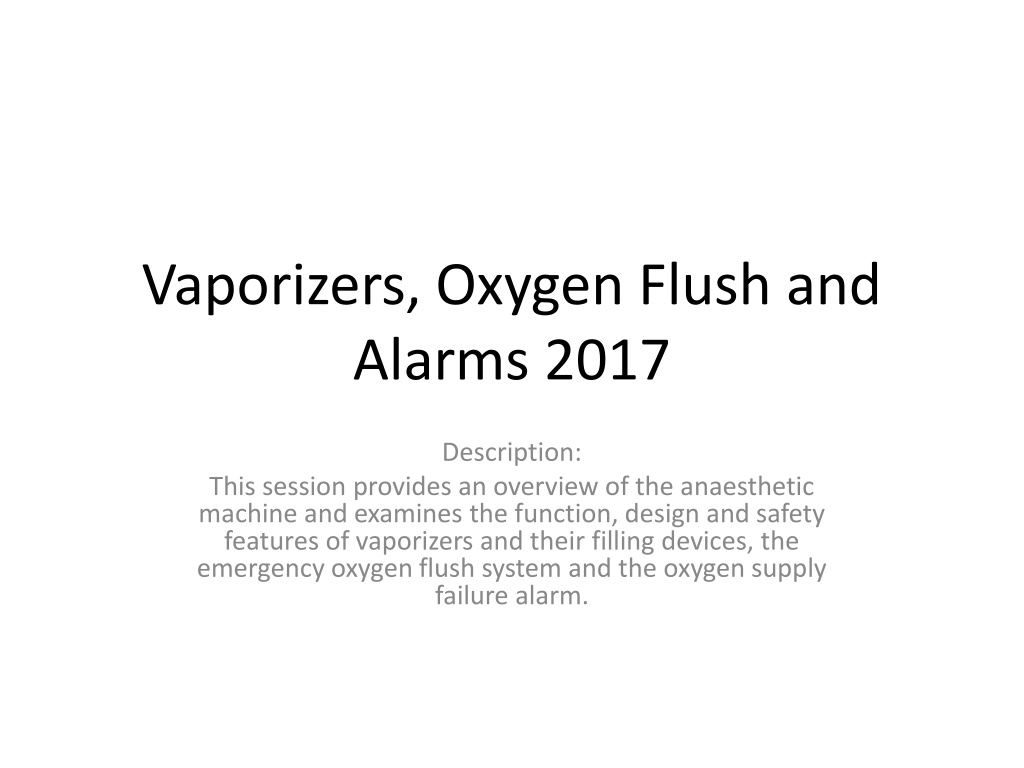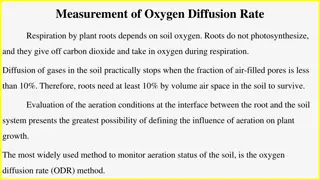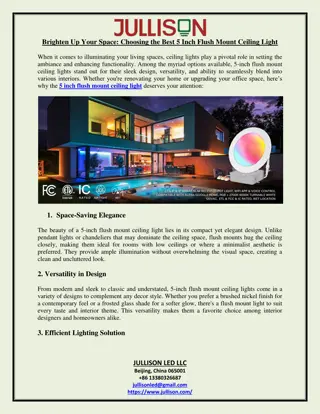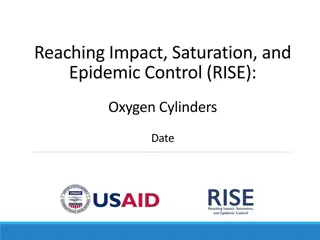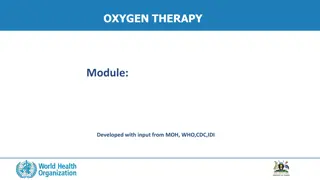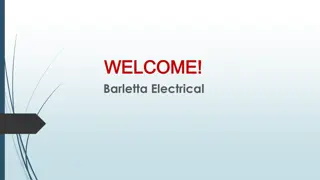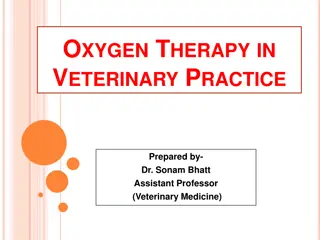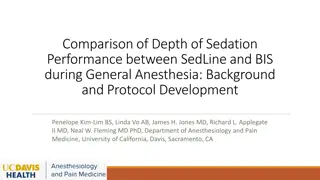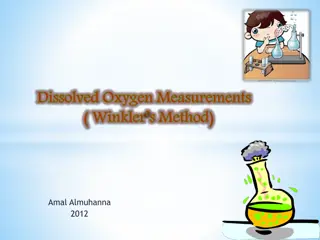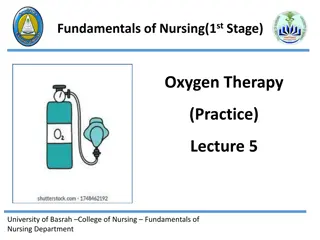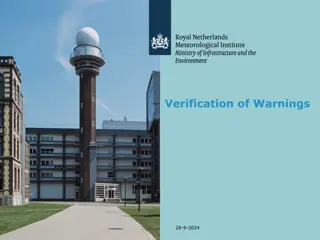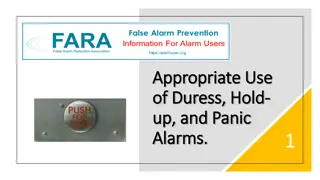Understanding Vaporizers, Oxygen Flush, and Alarms in Anesthetic Machines
This overview delves into the functionality and safety features of vaporizers, oxygen flush systems, and oxygen supply failure alarms in anesthetic machines. Learn how vaporizers work, their key design characteristics, and the importance of plenum vaporizers in anesthesia delivery.
Download Presentation

Please find below an Image/Link to download the presentation.
The content on the website is provided AS IS for your information and personal use only. It may not be sold, licensed, or shared on other websites without obtaining consent from the author. Download presentation by click this link. If you encounter any issues during the download, it is possible that the publisher has removed the file from their server.
E N D
Presentation Transcript
Vaporizers, Oxygen Flush and Alarms 2017 Description: This session provides an overview of the anaesthetic machine and examines the function, design and safety features of vaporizers and their filling devices, the emergency oxygen flush system and the oxygen supply failure alarm.
Session introduction Learning objectives: Describe the key features, functionality and safety features of vaporizers and their filling devices. Describe the key features, functionality and safety features of the emergency oxygen flush and oxygen supply failure alarm explain the function of the compressed oxygen outlets and common gas outlet of the anaesthetic machine
How vaporizers work A vaporizer is a device used to add a specific, controlled and predictable concentration of inhalational agent, in the form of a vapour, to the fresh gas flow (FGF) before it is delivered to the patient. The amount delivered is expressed as a percentage of saturated vapour add to the gas flow. The proportion of vapour containing gas and bypass gas is controlled by a dial. The basic design of vaporizer with a vaporizing chamber containing the liquid anaesthetic agent, and a bypass channel. FGF passing through the vaporizing chamber picks up the anaesthetic vapour. This is then mixed with the anaesthetic - free gas bypassing the chamber.
Functional characteristics Vaporizers need to incorporate several important design features in order to accommodate the physical properties of volatile inhalational agents and to control the transfer of heat caused by their vaporization. Functional characteristics of the ideal vaporizer; the ideal vaporizer performance would be unaffected by: 1. Changes in fresh gas flow 2. The volume of the liquid agent 3. Ambient temperature and pressure 4. Decrease in temperature due to vaporization 5. Pressure fluctuation due to the mod of respiration In addition, it should: 1. Have a low resistance to the flow 2. Be lightweight and have a small liquid requirement 3. Incorporate safety features to prevent accidental delivery of excessively high concentrations of the inhalational agent 4. Be economical in use, with minimal servicing requirements 5. Have a corrosion and solvent resistant construction
The Plenum Vaporizer The plenum vaporizer is situated outside the breathing system. Gases are driven through this high resistance and unidirectional vaporizer by gas supply pressure. The calibration of each vaporizer is agent specific. This type of vaporizer is the one usually seen on contemporary anaesthetic machines.
How The Plenum Vaporizer Works fresh gas flow is split in to two streams immediately on entry to the plenum vaporizer. One steam flows through the bypass channel and the other, a smaller stream, flows through the vaporizing chamber. The two gas streams reunite as the gas leaves the vaporizers. The gas in the vaporization chamber is always fully saturated with vapour before it rejoins the bypass gas stream. Full saturation with vapour is achieved by increasing the surface area of contact between the carrier gas and the anaesthetic agent. This is accomplished either by having wicks saturated by the inhalational agents, a series of baffles or by bubbling the gas through the liquid. The adjustment of the percentage control dial of the vaporizer alters the amount of flowing through the bypass channel to that flowing through the vaporization chamber. In the modern vaporizers, the inhalational agent concentration supplied by the vaporizer is virtually independent of the FGFs between 0.5 to 15L/min. This makes plenum vaporizers highly accurate and reliable in delivering the desired inhalational anaesthetic concentration, despite changes in fresh gas flow and temperature.
Features of Vaporizers Design As the inhalational agent evaporates, its temperature decreases due to the lost of latent heat of vaporization. A cold liquid is less volatile than a hot one so lowering the temperature of the inhalational agent makes it less volatile and the concentration carried by the FGF decreases. Modern vaporizers incorporate design features that overcome this challenge. Material: The material used in the vaporizers need to offer: 1. High density 2. High specific heat capacity 3. Very high thermal conductivity Copper acts as a heat sink, readily giving heat to the anaesthetic inhalational agent and maintaining its temperature.
Features of Vaporizers Design Temperature compensating valves: A temperature sensitive valve within the body of the vaporizer automatically adjusts the splitting ratio of FGF and inhalational agent. Temperature valves incorporate either a bellows design or a bimetallic strip. Bellows design: The bellows design allows more flow to the vaporizing chamber as temperature decreases. As the temperature decreases, the bellows contract, restricting the flow of fresh gas through the narrowed valve channel, thus allowing more flow through vaporizing chamber.
Features of Vaporizers Design Temperature compensating valves Bimetallic strip: The bimetallic strip is made of two strips of metal with different coefficients of thermal expansion bonded together. As the vaporizer is used, the temperature of the inhalational agent decreases. The strip bends so allowing more flow into vaporizing chamber to maintain the full saturation of the gas leaving it.
Features of Vaporizers Design Temperature compensating valves Bimetallic strip The temperature compensating valve with its bimetallic strip is positioned inside the vaporization chamber of the Tec MK 2 vaporizer, it was found that preservatives, such as thymol in halothane, can cause the bimetallic strep to stick, adversely affecting its action. although other inhalational agents do not contain preservatives, the chemically active bimetallic strep was liable to corrode in the oxygen/ inhalational agent mixture. The Tec MK3,4 and 5 designs, the bimetallic strep is located outside the vaporizing chamber and is thus less exposed to corrosion risk
Plenum Vaporizers Selectatec System The plenum vaporizers are mounted on the back bar of the anaesthetic machine using the interlocking Selectatec system. the Selectatec system features pins in the manifold that are linked into the control dial. The locking lever of the system has to be engaged before the percentage control dial can be moved. This means that the fresh gas flow only enters the vaporizer when it is has been switched on. In addition, the interlocking extension rods extend and prevent more than one vaporizer being switched on at any one time, preventing contamination of vaporizer positioned downstream.
Selectatec System Leakage: One downside of using the Selectatec interlocking system is that it increases the potential for leaks. There are O-rings positioned on the mounts where the vaporizer is positioned. As the vaporizers are changed, these O-rings can accidentally adhere to the vaporizer so causing a leak when another vaporizer is positioned. It is, therefore, essential to pay particular attention to the condition of the O-rings of the Selectatec system when carrying out the overall check of the anaesthetic equipment.
The Vaporizer Safety Feature Anti spell mechanism: Early designs of the Tec system allowed the liquid anaesthetic agent to enter the bypass channel by accident. Tipping the vaporizer upside down would cause spillage of the agent, leading to dangerously high concentrations of anaesthetic agent being delivered to the patient. The modern Tec MK 5 design incorporates an anti spill mechanism which prevents the liquid anaesthetic agents from entering the bypass channel even if the vaporizer is tipped upside down. Despite that, it is recommended that the vaporizer is purged with a fresh gas flow of 5L/min for 30min with the percentage control dial set at 5%.
The Vaporizer Safety Feature Pressure control: An obstruction at the common gas outlet of the anaesthetic machine can cause damage to the vaporizer and flowmeters. A non return pressure reliefe valve downstream of the vaporizer which opens at about 35 to 40KPa prevents the build up of pressure. Minute volume divider ventelators such as the Blease Manley exerts back pressures as they cycle. this back pressure forces some of the gas exeting the outlet port back into the vaporizing chamber, where more vapour is added. In addition, retrograte flow may also contaminate the bypass channel. These can cause an increase in the inspired concentration of the agent which may be toxic. These pressure fluctuations can be compensated for in several ways: Inlet port design Downstream flow restrictors Equal volume in bypass channel and vaporizing chamber.
The Vaporizer Safety Feature Pressure control Inlet port design: A long inlet port to the vaporizing chamber, as in the Tec MK 3, ensures that the bypass channel is not contaminated by retrograde flow from the vaporizing chamber. Downstream flow restrictors: These are used to maintain the vaporizer at a pressure greater than any pressure required to operate commonly used ventilators. Equal volume in bypass channel and vaporizing chamber: Both the bypass channel and the vaporizing chamber are of equal volume sag as expansion and compression equal.
The Vaporizer Safety Feature Agent specific filling devices: In order to prevent the risk of adding the wrong agent to the wrong vaporizer and to decrease the extent of spillage, agent specific vaporizer filling devices are used. These are geometrically coded (keyed) to fit the safety filling port of the correct vaporizer and anaesthetic agent supply bottle. These fillers are colour - coded: red: halothane Purple: isoflurane Yellow: sevoflurane Blue: desflurane This safety filling feature also ensures that the vaporizer cannot overflow, thereby reducing pollution in theater. The filler has an anti pollution cap. This allows it to be left fitted to the bottle between uses to prevent the agent from vaporizing. It also eliminates air locks, speeds up vaporizer filling and ensures that the bottle is completely emptied, so reducing wastage.
Emergency Oxygen Flush The emergency oxygen flush, when activated, supplies pure oxygen from the outlet of the anaesthetic machine. The flow bypasses the flowmeters and the vaporizers. A flow of about 35-75 L/min at a pressure of about 400 KPa is expected. The emergency oxygen flush is usually activated by a non-locking button and using a self-closing valve. It is designed to minimize unintended and accidental operation by staff. The button is recessed in a housing to prevent accidental depression. Excessive use of the emergency oxygen flush can put the patient at a higher risk of barotrauma due to the high operating pressure and flow of the oxygen flush. Inappropriate use can lead to the dilution of the anaesthetic gases mixture and possible awareness. It should not be activated while ventilating a patient using a minute volume divider ventilator.
Oxygen Supply Failure Alarm This indispensable alarm warns of a failure of the oxygen supply. In such situations, the nitrous oxide supply is automatically switched off as a safety measure, and air (with 21% oxygen) is delivered to the patient. The characteristics of the ideal warning (oxygen supply failure alarm) device: 1. Activation depends only on the pressure of oxygen 2. It requires no batteries or mains power 3. To attract attention, it gives a distinctive, audible signal of sufficient duration (at least 7 seconds) and volume (more than 60db at 1m distance from the front of the machine) 4. It gives a warning of impending failure and a further alarm that failure has occurred 5. It has pressure linked controls which interrupt the flow of all other gases when its operates. Atmospheric air is allowed to be delivered to the patient without carbon dioxide accumulation. It should be impossible to resume anaesthesia until the oxygen supply has been restored. 6. The alarm is positioned on the reduced pressure side of the oxygen supply line. 7. It should be tamper proof. The alarm can be switched off only by restoring the oxygen supply. 8. It is not affected by back pressure from the anaesthetic ventilator.
Compressed Oxygen Outlets and the Common Gas Outlet Modern anaesthetic machines have one or more compressed oxygen outlets that provide oxygen at about 400KPa. Such outlets can be used to drive ventilators or a manually- controlled jet injector. The mixture of gases and vapors exits the machine via a 22 mm male/15 mm female conically tapered pipe. It can be a fixed or a swiveling connector. The connector of the common gas outlet should be strong enough to withstand a torque of up to 10 Nm because of the heavy equipment that may be attached.
Session Key Points Vaporizers are made of copper as copper is a good heat sink material. They consist of a bypass channel and vaporization chamber. The latter has wicks to increase the surface area available for vaporization. The gas leaving the vaporing chamber is fully saturated Vaporizers have a temperature sensitive valve that controls the splitting ratio. They have colour and geometrically coded filling devices Vaporizers used for desflurane have different design modifications due to desfluranes unique physical properties. Emergency oxygen flush delivers 100% oxygen at flows of 35 to 75L/min. inappropriate use can cause barotrauma and potential awareness Oxygen supply failure alarms are activated by the oxygen pressure itself with no other power supply source they also allow the supply of ambient air
Session summary Learning objectives: Describe the key features, functionality and safety features of vaporizers and their filling devices Describe the key features, functionality and safety features of the emergency oxygen flush and oxygen supply failure alarm Explain the function of the compressed oxygen outlets and common gas outlet of the anaesthetic machine
